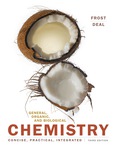
a.
To determine:
The number of each type of ion present in the ionic compound potassium chloride.
Introduction:
There are two types of monoatomic ions that contain single atom. One is cation like
Cations from the main group metals are typically named using the element name followed by the word ion. Cation formed by metals in other groups and at the bottom of the main group can have more than one positive charge.
Anions from the main group metals are named using the root of the element name followed by the ending –ide.
b.
To determine:
The number of each type of ion present in the ionic compound zinc oxide.
Introduction:
There are two types of monoatomic ions that contain single atom. One is cation like
Cations from the main group metals are typically named using the element name followed by the word ion. Cation formed by metals in other groups and at the bottom of the main group can have more than one positive charge.
Anions from the main group metals are named using the root of the element name followed by the ending –ide.
c.
To determine:
The number of each type of ion present in the ionic compound
Introduction:
There are two types of monoatomic ions that contain single atom. One is cation like
Cations from the main group metals are typically named using the element name followed by the word ion. Cation formed by metals in other groups and at the bottom of the main group can have more than one positive charge.
Anions from the main group metals are named using the root of the element name followed by the ending –ide.
Want to see the full answer?
Check out a sample textbook solution
Chapter 3 Solutions
EBK GENERAL, ORGANIC, AND BIOLOGICAL CH
- Draw the major products of the following reaction: HCIarrow_forwardFor each molecule, assign each stereocenter as R or S. Circle the meso compounds. Label each compound as chiral or achiral.arrow_forwardBlackboard app.aktiv.com X Organic Chemistry II Lecture (mx Aktiv Learning App Curved arrows are used to illustrate the flow of electrons. Using the provided starting and product structures, draw the curved electron-pushing arrows for the following reaction or mechanistic step(s). Be sure to account for all bond-breaking and bond-making steps. Problem 25 of 35 Select to Edit Arrows CH3CH2OK, CH3CH2OH L Gemini M 31 0:0 :0: 5x Undo Reset Done :0: Harrow_forward
- I have some reactions here for which I need to predict the products. Can you help me solve them and rewrite the equations, as well as identify the type of reaction? Please explain it to me.I have some reactions here for which I need to predict the products. Can you help me solve them and rewrite the equations, as well as identify the type of reaction? Please explain it to marrow_forwardDraw the major product of this reaction. Ignore inorganic byproducts. Problem 17 of 35 1. CH3CH2Li O H 2. Neutralizing work-up @ Atoms, Bonds and Rings Draw or tap a new boarrow_forwardWill this convert the C=O to an alcohol? Or does its participation in the carboxy group prevent that from happening?arrow_forward
- I have some reactions here for which I need to predict the products. Can you help me solve them and rewrite the equations, as well as identify the type of reaction? Please explain it to me.I have some reactions here for which I need to predict the products. Can you help me solve them and rewrite the equations, as well as identify the type of reaction? Please explain it to marrow_forwardDon't used hand raiting and don't used Ai solutionarrow_forwardCould you explain and label how this was determined for the functional groups? Please highlight the areas and show me as well.arrow_forward
 Chemistry: Principles and PracticeChemistryISBN:9780534420123Author:Daniel L. Reger, Scott R. Goode, David W. Ball, Edward MercerPublisher:Cengage Learning
Chemistry: Principles and PracticeChemistryISBN:9780534420123Author:Daniel L. Reger, Scott R. Goode, David W. Ball, Edward MercerPublisher:Cengage Learning Introductory Chemistry: A FoundationChemistryISBN:9781337399425Author:Steven S. Zumdahl, Donald J. DeCostePublisher:Cengage Learning
Introductory Chemistry: A FoundationChemistryISBN:9781337399425Author:Steven S. Zumdahl, Donald J. DeCostePublisher:Cengage Learning ChemistryChemistryISBN:9781305957404Author:Steven S. Zumdahl, Susan A. Zumdahl, Donald J. DeCostePublisher:Cengage Learning
ChemistryChemistryISBN:9781305957404Author:Steven S. Zumdahl, Susan A. Zumdahl, Donald J. DeCostePublisher:Cengage Learning
 Chemistry: The Molecular ScienceChemistryISBN:9781285199047Author:John W. Moore, Conrad L. StanitskiPublisher:Cengage Learning
Chemistry: The Molecular ScienceChemistryISBN:9781285199047Author:John W. Moore, Conrad L. StanitskiPublisher:Cengage Learning





